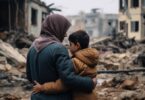The Universal Declaration of Human Rights (UDHR) was established in response to the atrocities during WWII, including the Holocaust. The document outlines the human rights that all people are entitled to such as freedom from torture, freedom of expression, and the right to seek asylum. When those rights aren’t protected or blatantly disregarded, they are violated. What are the types of human rights violations? Who is responsible for preventing and addressing them?
Definition and types of human rights violations
A state commits human rights violations either directly or indirectly. Violations can either be intentionally performed by the state and or come as a result of the state failing to prevent the violation. When a state engages in human rights violations, various actors can be involved such as police, judges, prosecutors, government officials, and more. The violation can be physically violent in nature, such as police brutality, while rights such as the right to a fair trial can also be violated, where no physical violence is involved.
The second type of violation – failure by the state to protect – occurs when there’s a conflict between individuals or groups within a society. If the state does nothing to intervene and protect vulnerable people and groups, it’s participating in the violations. In the United States, the state failed to protect black Americans when lynchings frequently occurred around the country. Since many of those responsible for the lynchings were also state actors (like the police), this is an example of both types of violations occurring at the same time.
Examples of human rights violations
We’ve mentioned a few examples of human rights violations, but there are many more. Civil, political, economic, cultural, and social rights can all be violated through various means. Though all the rights enshrined in the Universal Declaration of Human Rights and in the legally binding International Covenants of Human Rights (ICCPR, CESCR) are considered essential, there are certain types of violations we tend to consider more serious. Civil rights, which include the right to life, safety, and equality before the law are considered by many to be “first-generation” rights. Political rights, which include the right to a fair trial and the right to vote, also fall under this category.
Civil and political rights
Civil and political rights are violated through genocide, torture, and arbitrary arrest. These violations often happen during times of war, and when a human rights violation intersects with the breaking of laws about armed conflict, it’s known as a war crime.
Conflict can also trigger violations of the right to freedom of expression and the right of peaceful assembly. States are usually responsible for the violations as they attempt to maintain control and push down rebellious societal forces. Suppressing political rights is a common tactic for many governments during times of civil unrest.
Violations of civil and political human rights aren’t always linked to specific conflicts and can occur at any given time. Human trafficking is currently one of the largest issues on a global scale as millions of men, women, and children are forced into labor and sexual exploitation. Religious discrimination is also very common in many places around the world. These violations often occur because the state is failing to protect vulnerable groups.
Economic, social, and cultural rights
As described in the UDHR, economic, social, and cultural rights include the right to work, the right to education, and the right to physical and mental health. As is the case with all human rights, economic, social, and cultural rights can be violated by states and other actors. The United Nations Office of the High Commissioner for Human Rights gives a handful of examples of how these rights can be violated. They include:
- Contaminating water, for example, with waste from State-owned facilities (the right to health)
- Evicting people by force from their homes (the right to adequate housing)
- Denying services and information about health (the right to health)
- Discriminating at work based on traits like race, gender, and sexual orientation (The right to work)
- Failing to provide maternity leave (protection of and assistance to the family)
- Not paying a sufficient minimum wage (rights at work)
- Segregating students based on disabilities (the right to education)
- Forbidding the use of minority/indigenous languages (the right to participate in cultural life)
Who is ultimately responsible for ensuring human rights violations don’t happen?
In human rights treaties, states bear the primary burden of responsibility for protecting and encouraging human rights. When a government ratifies a treaty, they have a three-fold obligation. They must respect, protect, and fulfill human rights. When violations occur, it’s the government’s job to intervene and prosecute those responsible. The government must hold everyone (and itself) accountable.
This doesn’t mean that members of civil society don’t also have a responsibility to prevent human rights violations. Businesses and institutions must comply with discrimination laws and promote equality, while every individual should respect the rights of others. When governments are violating human rights either directly or indirectly, civil society should hold them accountable and speak out. The international community also has an obligation to monitor governments and their track records with human rights. Violations occur all the time, but they should always be called out.












